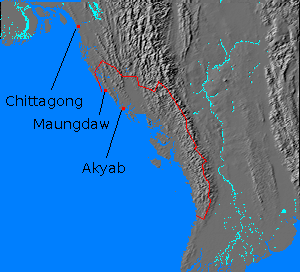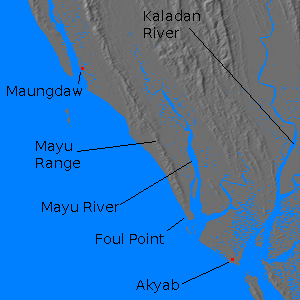![]() The Pacific War Online Encyclopedia
The Pacific War Online Encyclopedia
|
| Previous: Arakabesan | Table of Contents | Next: Araki Keikichi |
 |  |
The Arakan is the western coastal region of Burma. It is separated from the rest of the country by the Yoma mountain range and its terrain is characterized by jungle and coastal swamps. Although rice is produced in the area and exported through the port of Maungdaw, the chief strategic prize was the island of Akyab, whose airfield would be useful both for protecting Calcutta and for projecting air power towards Rangoon. The latter was considered a prerequisite for any amphibious assault on southern Burma.
The nearest supply port for the British was at Chittagong and the communications from there south were nonexistent. Transport was largely by water, and the only real road in the region
was from Maungdaw inland across the Mayu Range (including two tunnels). The climate was fairly dry from October to May, but during the summer monsoon up to 200" (500 cm) of rain fell in the region.
The first British counteroffensive in Burma was an attempt to
recapture Akyab in
late 1942. Intelligence reported just four Japanese battalions in the area, and even this was an overestimate, as the Japanese initially had just two battalions of 213 Regiment (Miyaki Force,
3600 men) in the Arakan. The
objective was a modest 90 miles (145 km) from the British lines, though
the intervening country had very poor communications. The campaign was
undertaken mostly
as a demonstration that Britain was serious about fighting Japan.
The original plan was for 14 Indian Division under W.L. Lloyd to pin down the Japanese while 29 Indian Brigade would conduct a seaward assault on Akyab using landing craft. However, 29 Brigade, which had suffered a high malaria rate in the occupation of Madagascar, could not be ready in time, and 14 Indian Division became the main assault force. Accordingly, on 17 December 1942 the division struck out from Cox's Bazaar (91.981E 21.442N) for Akyab, with 47 Brigade advancing on both sides of the Mayu Range towards Foul Point while 123 Brigade advanced down the east bank of the Mayu River. 55 Brigade remained in reserve in Chittagong, and for the final assault Lloyd could call on 6 Brigade with 72 landing craft and eight other small craft. Resistance was initially light, poor intelligence and the terrain proving a more formidable obstacle than the enemy. The Japanese had vacated the road from Maungdaw to Buthidaung and 14 Division occupied this key position on 22 December. By the end of the month the division was within ten miles of Akyab, where it encountered heavy resistance just north of Donbaik in the form of log and earth bunkers.
47 Brigade attacked the Japanese line on 7 January without success. Larger attacks on 8 and 9 January simply increased the casualty count, to over 200 British troops. 123 Brigade was also held up, having been beaten in the race to Rauthedaung, a crucial crossroads east of the Mayu River, by just a few hours. By 10 January the British were at a standstill. Lloyd requested tank support, but despite warnings by Slim that tanks must be used en masse, just 8 Valentine tanks were committed. An attack by 55 Brigade on 1 February with tank support was thrown back with heavy losses.
The Indian troops continued to throw themselves against the Japanese defenses throughout February and March, usually in unimaginative frontal assaults that were easily defeated by Japanese flanking fire. Morale plummeted. On 7 March, following the arrival of 55 Division in the area, the Japanese counterattacked from the Kaladan River valley across ridges the British had assumed were impassible, falling on the British lines of communication on the east side of the Mayu Peninsula. Irwin was forced to commit 71 Indian Brigade to help extricate 123 Brigade. Eventually 14 Division was reinforced to a total of nine brigades, normally equivalent to three divisions. However, Slim's call for a corps command for the operation was ignored by Irwin.
On 24 March the Japanese crossed the Mayu River. Lloyd was relieved by Irwin, who took personal command long enough to stabilize the situation. Irwin then turned command of the force over to Cyril Lomax on 3 April. That same day, the Japanese struck against the lines of communication on the west side of the Mayu Peninsula, capturing the 6 Brigade headquarters, and on 5 April Slim was finally authorized to form a corps headquarters and attempt to retrieve the situation. An attempt to ambush the Japanese on the Maungdaw-Buthidaung road proved beyond the capabilty of the tired troops. At this point, Slim could do nothing more than extricate his force, which was back in Chittagong by the end of May. Irwin was subsequently replaced by Sir George Giffard.
Total Commonwealth casualties were about 916 killed, 2889 wounded, and 1252 missing, while the Japanese losses were about 611 killed and 1165 wounded.
Following this debacle, the Indian Army began a program of comprehensive training in jungle warfare. This included the activation of two training divisions and the distribution of a pamphlet on jungle warfare that wags promptly dubbed The Jungle Book. At the same time, Slim and other commanders worked to improve their logistics by extending the rail and road network and to improve readiness by implementing effective malaria control measures. A new operational headquarters, Southeast Asia Command, was established under Mountbatten while GHQ India, now under Auchinleck, provided logistics and training.
Slim,
now in command of the newly activated 14 Army, made a
second attempt to seize
Akyab in January 1944. The attacking force was XV
Indian Corps (5
and 7
Indian Divisions and 81
West African Division) under A.F.P.
Christison, which this time had heavy air support. 5
Indian Division (Briggs) advanced on the west side of the Mayu Range while 7
Indian
Division (Messervy) advanced on the east side of the range, and 81 West African
Division (Loftus-Tottenham) operated further east to cover the flank of the advance. 5 and
7 Indian Divisions were expected to improve the road network as they
advanced while 81
West African Division was to be supplied by air. In the event of a
Japanese counterattack against their communications, 5 and 7 Indian
Divisions were to form a perimeter defense (a "box") to repel the
counterattack. Meanwhile 26 Indian Division (Lomax) was held in reserve. By 9 January the British had reached the Maungdaw-Buthidaung road again.
Kawabe Masakazu waited until
he judged the British lines of communication
were badly stretched before ordering 28 Army to launch its
counterattack (Ha-Go). 55 Division (Hanaya) began
to advance in four columns on 11 January 1944, with orders to destroy
or at least tie down the British divisions in the Arakan so that they
could not reinforce Imphal to the north. Hanaya himself had ambitions of seizing Chittagong to join Mutaguchi's move into Assam. Hanaya's infantry group commander, Sakurai Tokutaro,
would attempt a flanking movement east of the Mayu River, seize Taung
Bazar northeast of the British, and fall upon the British
communications.
On 3 February 1944 Sakurai found a gap between 7 Indian
and 81
West Africa Division and punched through to the 7 Indian Division's
main supply dump and division headquarters. The resulting Battle of the
Admin Box saw the headquarters of 7 Indian Division almost destroyed
and the division cut off from 5 Indian Division, with Messervy himself
narrowly escaping from the Japanese. However, 7 Indian Division
did not fall apart, and it was able to establish its defensive boxes. Warned
in advance by the code
breakers of the Japanese move,
Slim prepared to resupply 7 Indian Division
by air while 5
Indian Division and 26
Indian Division closed in to form the
hammer that
smashed the Japanese against the 7 Indian Division anvil.
This strategy was successful, though the unusually generous allotment of Japanese air power to the operation threatened to cut the air supply line. About 100 Ki-43 "Oscar" and Ki-44 "Tojo" fighters of 5 Air Division swept the area on the first day of the operation, and as many as 60 sorties were flown on some days thereafter. The American air transport commander, William Old, personally led the transport flights after the first flights turned back in the face of fighter opposition. However, the three squadrons of defending Spitfires rapidly established air superiority, shooting down 65 Japanese fighters at the cost of just three Spitfires in the first two weeks of the battle. There remained the threat of hostile light antiaircraft weapons near the drop zones, and drops eventually had to be made at night. Most drops were made using jute parachutes that were not as effective as silk but at 1/20th the cost.
During the Battle of the Admin Box, the Japanese overran a British field hospital. The next morning, four doctors and 31 patients were massacred by their Japanese captors.
Armor and artillery
were key to the British defense of the Admin Box. The crisis of the
battle came at C Company Hill, which commanded the battlefield and was
captured by the Japanese on 16 February. The Japanese were driven off
by infantry supported by ten Lee tanks, which eventually had to switch
to firing solid shot instead of high explosive to avoid hitting their own men in the close quarters fighting.
Both sides suffered heavy casualties, but the three Japanese battalions
were reduced in strength from 2190 to 400 men between 11 and 21
February. Their commander, Tanahashi, cut his own phone lines rather than obey an order to attack yet again.
7 Indian Division was relieved on 24 February, when Tanahashi pulled his exhausted force out to the south. By early March the British had returned to the offensive, and by June Hanaya was in retreat. The victory demonstrated that Indian troops could defeat the Japanese. Morale in the Indian Army soared. However, Akyab itself was not seized until 12 January 1945, when British Marines landed under cover of the battleship guns of the Far East Fleet. The airfield became a vital base for air supply of 14 Army in its final dash to Rangoon.
References
The Pacific War Online Encyclopedia © 2010-2011, 2014 by Kent G. Budge. Index